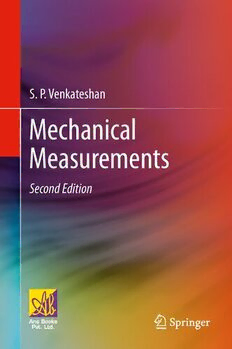
Mechanical Measurements PDF
Preview Mechanical Measurements
S. P. Venkateshan Mechanical Measurements Second Edition Mechanical Measurements S. P. Venkateshan Mechanical Measurements Second Edition S.P.Venkateshan DepartmentofMechanicalEngineering IndianInstituteofTechnologyMadras Chennai,TamilNadu,India ISBN978-3-030-73619-4 ISBN978-3-030-73620-0 (eBook) https://doi.org/10.1007/978-3-030-73620-0 JointlypublishedwithANEBooksIndia. Theprintededition,thereisalocalprintededitionofthisworkavailableviaAneBooksinSouthAsia (India, Pakistan, Sri Lanka, Bangladesh, Nepal and Bhutan) and Africa (all countries in the African subcontinent). ISBNoftheCo-Publisher’sedition:978-9-383-65691-2 1stedition:©AneBooksPvt.Ltd2008 2ndedition:©TheAuthor(s)2022 Thisworkissubjecttocopyright.AllrightsaresolelyandexclusivelylicensedbythePublisher,whether thewholeorpartofthematerialisconcerned,specificallytherightsoftranslation,reprinting,reuse ofillustrations,recitation,broadcasting,reproductiononmicrofilmsorinanyotherphysicalway,and transmissionorinformationstorageandretrieval,electronicadaptation,computersoftware,orbysimilar ordissimilarmethodologynowknownorhereafterdeveloped. Theuseofgeneraldescriptivenames,registerednames,trademarks,servicemarks,etc.inthispublication doesnotimply,evenintheabsenceofaspecificstatement,thatsuchnamesareexemptfromtherelevant protectivelawsandregulationsandthereforefreeforgeneraluse. Thepublishers,theauthors,andtheeditorsaresafetoassumethattheadviceandinformationinthisbook arebelievedtobetrueandaccurateatthedateofpublication.Neitherthepublishersnortheauthorsor theeditorsgiveawarranty,expressorimplied,withrespecttothematerialcontainedhereinorforany errorsoromissionsthatmayhavebeenmade.Thepublishersremainneutralwithregardtojurisdictional claimsinpublishedmapsandinstitutionalaffiliations. ThisSpringerimprintispublishedbytheregisteredcompanySpringerNatureSwitzerlandAG Theregisteredcompanyaddressis:Gewerbestrasse11,6330Cham,Switzerland Dedicated tothe ShakkottaiFamily Preface to the Second Edition Thesecondeditionofthebookhasbeenthoroughlyrevisedandallerrorsthathave cometomynoticehavebeencorrected.Additionshavebeenmadeatvariousplaces in the book. Notable additions are in the statistical analysis of measured data in ModuleI.Importantquestionsregardingnormalityofdeviationsandidentification of outliers have been discussed in great detail. These should interest the advanced readerwhoislookingforanunderstandingoftheseissues.Thermistorshavebeen describedingreaterdetailinChap.4.Also,thelinereversaltechniqueofmeasuring gastemperaturehasbeendescribedingreaterdetail.Theoryoftheintegratingsphere hasbeendiscussedindetailinChap.12.ModuleVhasbeenaugmentedwithmore examplesfromlaboratorypractice.Exercisesarenowpositionedattheendofeach module.Manynewexerciseproblemshavebeenaddedinthisedition. The modules have been rearranged with the number of chapters going up by one to a total of sixteen chapters in this edition. Many references are indicated as footnotesinthetextapartfromthebibliographyandthelistofreferencesgivenin the Appendix. All illustrations have been redrawn for this edition using “tikz”—a program environment compatible with “latex”. All graphs have been replotted for thiseditionusingQtiPlot.Ingeneral,theseweredonetoimprovethequalityofthe illustrationsandalsotobringuniformityintheformat. Itishopedthatthesecondeditionwillbereceivedwiththesameenthusiasmas theoriginaleditionbythestudentcommunity. Chennai,India S.P.Venkateshan vii Preface to the First Edition Inrecenttimestherehavebeenrapidchangesinthewayweperceivemeasurements becausenewtechnologieshavebecomeaccessibletoanyonewhocarestousethem. ManyoftheinstrumentsthatonetakesforgrantednowwereactuallynottherewhenI startedmyengineeringstudiesinthe1960s.Thetrainingthatwereceivedthosedays, inMechanicalEngineering,didnotincludeastudyof“MechanicalMeasurements”. Whateverwaslearntwaspurelybydoingexperimentsinvariouslaboratoryclasses! ElectricalEngineerswerebetteroffbecausetheystudied“ElectricalMeasurement” forayear.Thesemestersystemwastobeintroducedfarinthefuture.Evenwhen “MechanicalMeasurements”wasintroducedasasubjectofstudy,theprinciplesof measurementswereneverdiscussedfully,theemphasisbeingthedescriptivestudy of instruments! In those days, an average mechanical engineer did not have any background in measurement errors and their analysis. Certainly he did not know muchaboutregression,designofexperiments,andrelatedconcepts. Atthattimetheintegratedchipwastoappearinthefutureandthedigitalcomputer was in its infancy. We have seen revolutionary changes in both these areas. These developmentshavechangedthewaywelookatexperimentsandtheartandscience of measurements. The study of measurements became divorced from the study of instrumentsandtheattentionshiftedtothestudyofthemeasurementprocess.The emphasis is more on knowing how to make a measurement rather than with what. Onechoosesthebestoptionavailablewithreasonableexpenseandconcentrateson doingthemeasurementwell. I have been teaching a course that was known as “Measurements in Thermal Science”foralmost20years.Thenthetitlechangedto“MeasurementsinThermal Engineering”!Theemphasisofthecourse,however,hasnotchanged.Thecourseis onesemesterlongandthestudentlearnsaboutthemeasurementprocessforalmost thirdofthisduration.Afterheunderstandstheprinciplesheisreadytolearnabout measurementofquantitiesthatareofinteresttoamechanicalengineer.Thecourse stressestheproblem-solvingaspectratherthanthemundanedescriptiveaspects.The studentisaskedtouselibraryandwebresourcestolearnaboutinstrumentsonher/his own. In the meanwhile, I have produced a video series (40 lectures each of 55 mins durationon“Measurements inThermalScience”) thathasbeenwidelycirculated. ix x PrefacetotheFirstEdition ThankstotheNPTELproject(NationalProgramforTechnologyEnhancedLearning) Ihadanopportunitytobringoutanothervideolectureseries(50lecturesof55mins durationeach,thistimecalled“MechanicalMeasurements”).Thisisbeingbroadcast overthe‘TechnologyChannel’.AlsoIhavepreparedafivemodulewebcoursewith thesametitle.InterestedreadercanaccessthewebcoursethroughtheIITMadras web site. This effort has encouraged me to write a more detailed book version of “MechanicalMeasurements”thatisnowinyourhands. Ihavearrangedthisbookinfiveparts,eachpartbeingreferredtoasamodule. Details of what is contained in each module is given in an abstract form at the beginning of each module. It has taken me close to three years to produce this book. Over this period I have improved the readability of the text and weeded out unnecessarymaterialandhavetriedtogivetothereaderwhatIbelieveisimportant. Ihavetriedtogiveabalancedtreatmentofthesubject,tryinghardtokeepmybias forthermalmeasurements! Thetextcontainsmanyworkedexamplesthatwillhelpthereaderunderstandthe basicprinciplesinvolved.Ihaveprovidedalargenumberofproblems,attheendof thebook,arrangedmodulewise.Theseproblemshaveappearedintheexamination papersthatIhavesetforstudentsinmyclassesovertheyears.Theproblemshighlight thekindofnumericsthatareinvolvedinpracticalsituations.Eventhoughthetextis intendedtobeanundergraduatetextbookitshouldinterestpracticingengineersor anyonewhomayneedtoperformmeasurementsasapartofhisprofessionalactivity! Iplacethebookinthehandsoftheinterestedreaderinthehopethathewillfindit interestingandworthhiswhile.Thereadershouldnotbecontentedwithastudyof the book that contains a large number of line drawings that represent instruments. Heshouldspendtimeinthelaboratoryandlearnhowtomakemeasurementsinthe realworldfullofhardware! Chennai,India S.P.Venkateshan Acknowledgements The writing of the book has involved support from several people. My research scholarshaveextendedcooperationduringtherecordingofthevideolectures.The feedback received from them—Dr. Rameche Candane, Mr. M. Deiveegan, Mr. T. V. V. Sudhakar, and Mr. G. Venugopal—helped in correcting many errors. Their feedback also helped me in improving the material while transforming it into the bookform.ThephotographsusedinthebookhavebeentakenbyMr.M.Deiveegan withassistancefromG.VenugopalintheHeatTransferandThermalPower,Internal CombustionEnginesandtheThermalTurbomachinesLaboratories,Departmentof MechanicalEngineering,IITMadras.IamgratefultoProf.B.V.S.S.S.Prasadfor permittingmetotakepicturesoftheheatfluxgages.Mr.T.V.V.SudhakarandMr. G.Venugopalhavealsohelpedmebysittingthroughtheclassesin“Measurements inThermalEngineering”andalsobyhelpingwiththesmoothrunningofthecourse. TheatmosphereintheHeatTransferandThermalPowerLaboratoryhasbeenhighly conducive for the book writing activity. The interest shown by my colleagues has beenhighlyencouraging. ManycorrectionswerebroughttomynoticebyMr.RenjuKurianandMr.O.S. Durgam,whowentthroughthefirsteditionverycarefully.Ithankbothofthemfor thishelp.Ithank Dr.Eng.MostafaAbdel-Mohimen, Benha University,Egypt,for pointingoutmistakesinthefigureandcorrespondinglythedescriptionofdiaphragm type pressure gauge. Corrections have been made in the revised second edition. I acknowledgetheinput,tothisbook,ofDr.PrasannaSwaminathan,whodesigneda classfilecalled“bookspv.cls”whichhasmadeitpossibletoimprovetheaesthetic qualityofthebook. S.P.Venkateshan xi Nomenclature Note:(1)Symbolshavingmorethanonemeaningarecontextspecific. (2)SparinglyusedsymbolsarenotincludedintheNomenclature. LatinAlphabeticalSymbols a Acceleration,m/s2orSpeedofsound,m/sorAnyparameter,appropriate unit A Area,m2 c Callendar correction, ◦C or Linear damping coefficient, N ·s/m or Gas concentration,m−3orSpeedoflight,3×108m/s C Specificheat,J/kg◦CorCapacitanceofaliquidsystem,m2orCapacitance ofagassystem,m·s2 orElectricalcapacitance, F C Coefficientofdischarge,nounit d C Dragcoefficient,nounit D C Specificheatofagasatconstantpressure, J/kg◦C p C Specificheatofagasatconstantvolume, J/kg◦C V D Diameter,m d Diameter,m orDegreesoffreedomorPiezoelectricconstant,Coul/N E Electromotive force (emf), V or Emissive power, W/m2 or Young’s modulus, Pa E Totalemissivepowerofablackbody,W/m2 b Ebλ Spectralemissivepowerofablackbody,W/m2μm E Shearmodulus, Pa s E˙ Enthalpyflux,W/m2 f Frequency,s−1or HzorFrictionfactor,nounit f Dopplershift, Hz D F Force, N FA Fuelairratio,kg(fuel)/kg(air) g Accelerationduetogravity,standardvalue9.804m/s2 xiii
